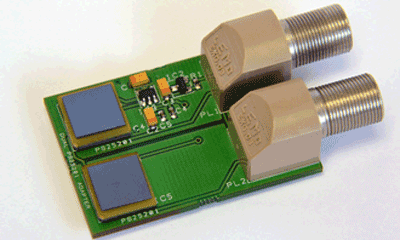Plessey Semiconductors demonstrate contactless gesture recognition technology for laptops, tablets, more
Company showcases impressive capabilities for developing field at CES 2013
BY JEFFREY BAUSCH
Plessey Semiconductors is demonstrating its imPart gesture-recognition technology at CES 2013 and it’s impressive for two reasons: one, it’s contactless and functions very well and two, the company has found a way to develop this technology while keeping costs minimal.
Translation: It’ll be easier for manufacturers of computer monitors, laptops, ultra books, and tablets to eventually incorporate this exciting new technology into their devices.

Plessey’s low-cost imPart gesture technology can be incorporated into devices like tablets.
The goal, at least for Plessey, is for the technology to be incorporated into the hardware of these systems so that the devices themselves can be activated without having to touch them: a swipe in the air, flick of the finger, moving one’s hand up or down is all it should takes to power the device on. And it’s not just power-on capabilities — a typical function like a “left-click” of the mouse can be performed by hovering one’s hand for more than half-a-second.
How do they do it? Well, at the core of this technology is Plessey’s award-winning EPIC sensor technology.

The EPIC sensor, developed by Plessey.
The sensors, already known throughout the industry for their quality and effectiveness, detect changes in electric potential.
A bit more specifically, the EPIC sensor detects changes in electric potential in muscles or nerves, or changes in the Earth’s atmospheric electric potential field caused by a hand / body moving through it. The technology itself, more or less, functions as an input impedance sensor, serving as a highly stable, extremely sensitive voltmeter to measure tiny charges in the electric field — all the way down to millivolts.
For this reason, the EPIC sensor has seen greater and greater inclusion in technologies such as ECG monitors for remote health and fitness applications. The company hopes that device manufacturers will now see it as a viable alternative to creating gesture-enabled computer screens without having to incorporate expensive, power-hungry, capacitive touchscreen technology or cameras.
Plessey’s Director of Business Development, Steve Cliffe, explains why he thinks CES 2013 is the right place to debut imPart: “CES is the perfect showcase for this stunning new technology. People are amazed at how sensitive it can be at picking up very small signals even at a distance of up to 100 cm without physical contact.”
Judging by how crowded the booth looked, it’s fair to say that everyone is fairly impressed with the performance capabilities of the company’s technology.
Cliffe adds: “For CES, we have created an imPart reference design that we expect to see a number of OEMs pick up to implement as a contactless pointing device for their own products. The applications are endless.”
Plessey Semiconductor’s EPIC Sensor received a 2011 Product of the Year Award from Electronic Products. For more on this amazing piece of technology, you can read Electronic Products’ Story Behind the Story and read this article about how the technology was used to create a heart monitor in a wristwatch.
Electronic Products is at CES2013! Follow us on Twitter @ElectronicProd or on Facebook (facebook.com/ElectronicProductsMagazine). ■
Advertisement
Learn more about Electronic Products Magazine





